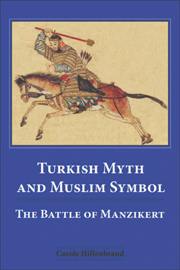Book contents
- Frontmatter
- Contents
- List of figures
- List of plates
- Acknowledgements
- Comment on transliteration and conventions used in the book
- Dedication
- Part 1 Medieval Muslim interpretations of the battle of Manzikert
- 1 Introduction
- 2 The twelfth-century accounts of the battle of Manzikert
- 3 The thirteenth-century accounts of the battle of Manzikert
- 4 The fourteenth- and fifteenth-century accounts of the battle of Manzikert
- 5 Writing the battle
- Part 2 The legacy of the battle
- Conclusion
- Appendix A The account of the battle of Manzikert by Michael Attaleiates, translated by Ruth Macrides
- Appendix B Translations of some other medieval Christian accounts of the battle of Manzikert
- Appendix C Other medieval Muslim accounts of the battle of Manzikert
- Bibliography
- Index
- Plate section
2 - The twelfth-century accounts of the battle of Manzikert
from Part 1 - Medieval Muslim interpretations of the battle of Manzikert
Published online by Cambridge University Press: 05 August 2013
- Frontmatter
- Contents
- List of figures
- List of plates
- Acknowledgements
- Comment on transliteration and conventions used in the book
- Dedication
- Part 1 Medieval Muslim interpretations of the battle of Manzikert
- 1 Introduction
- 2 The twelfth-century accounts of the battle of Manzikert
- 3 The thirteenth-century accounts of the battle of Manzikert
- 4 The fourteenth- and fifteenth-century accounts of the battle of Manzikert
- 5 Writing the battle
- Part 2 The legacy of the battle
- Conclusion
- Appendix A The account of the battle of Manzikert by Michael Attaleiates, translated by Ruth Macrides
- Appendix B Translations of some other medieval Christian accounts of the battle of Manzikert
- Appendix C Other medieval Muslim accounts of the battle of Manzikert
- Bibliography
- Index
- Plate section
Summary
Alp Arslan was the first of the kings of the Turks to cross the Euphrates.
The account of al-Turtushi (d. 520/1126) in Sirāj al-mulūk
Introduction to the text
Al-Turtushi was a leading religious and intellectual figure of his time. In 476/1084 he went east, as was frequently the custom with aspiring scholars from al-Andalus, and after performing the pilgrimage, he travelled widely in the Levant before finally settling in Alexandria. In the course of his travels, he met Ibn Tumart, al-Ghazali and other famous Muslim scholars and leaders. It is interesting to note that he had contact with teachers at the famous Nizamiyya madrasa in Baghdad where he established himself in 478/1085, and he might even have encountered Alp Arslan's vizier, Nizam al-Mulk, who by then was working for Malikshah, Alp Arslan's son and heir to the Seljuq sultanate. Even if the two men never met each other, al-Turtushi would have had access to stories and information from circles close to the Seljuqs and he would have heard about the battle of Manzikert, possibly even from eye-witnesses quite soon after the battle, when memories were fresh. It is clear that al-Turtushi admired Nizam al-Mulk, eulogising at length in Chapter 48 his remarkable skills in governing, and he talks in particular about his achievements in setting up the network of Nizamiyya madrasas throughout the Seljuq realm.
- Type
- Chapter
- Information
- Turkish Myth and Muslim SymbolThe Battle of Manzikert, pp. 26 - 51Publisher: Edinburgh University PressPrint publication year: 2007



